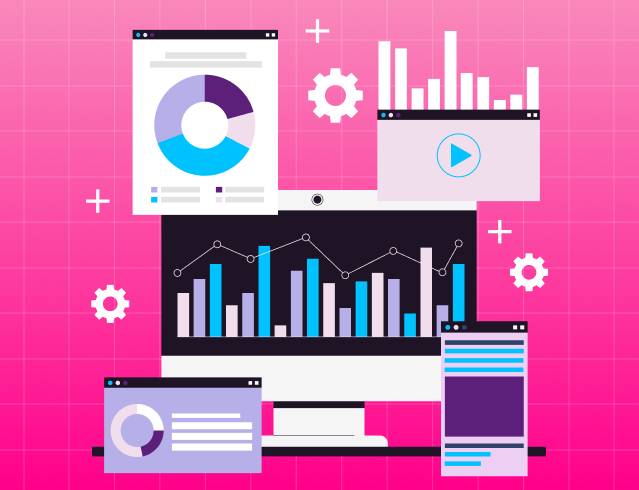AaaS (Analytics as a Service) allows companies to outsource their data analytics and BI functions to specialized vendors who provide cloud-based tools on a subscription model. This approach eliminates the need for in-house IT teams or extensive infrastructure, making analytics accessible to users without a technical background. With fully customizable BI solutions, AaaS encompasses all the critical functionalities required for data analysis and reporting.
As big data becomes increasingly vital, the costs of processing massive datasets are driving many CIOs to choose AaaS over traditional on-premise solutions. AaaS offers a cheaper, more scalable alternative, using advanced techniques like data mining and AI to uncover trends and insights that once required large teams of data engineers.
Today, businesses of any size can leverage AaaS to cleanse, analyze, and transform data into actionable insights more efficiently than ever. Whether fully web-based or part of a hybrid solution integrated with on-premise systems, AaaS empowers organizations to make informed decisions quickly and at scale.
Historical Development

Imagine stepping back into the 1990s, when data warehousing was the cornerstone of managing enterprise data. During this time, the “Data Warehouse in a Box” (DWIB) became a go-to solution for many organizations. DWIB offered a pre-packaged, on-site setup that simplified the creation of a data warehousing system.

Companies would pour significant investment into specialized hardware and software to store and manage their data, often dealing with complex integration processes and substantial upfront expenses. The goal of DWIB was to centralize data from multiple sources, enabling businesses to conduct reporting and analysis.

However, these systems came with their own set of challenges, such as limited scalability, the ongoing burden of maintenance, and the high costs associated with both initial setup and continued management.

Fast forward to today, and Analytics-as-a-Service (AaaS) offers a much more appealing alternative. Leveraging the cloud, AaaS provides flexibility, scalability, and cost-effectiveness that traditional on-premises solutions simply can’t match.

Analytics capabilities can be accessed on the web with AaaS, eliminating the need to host dedicated infrastructure at a business location. This is a modernistic idea that offers integration simplicity because of ready-made data connectors, seamless scalability through cloud resources with the capability to ramp up or down as needed, and lower costs in upfront plans via subscription-based models.

Again, maintenance and infrastructural management remain in the hands of the AaaS provider, leaving the organization to only worry about analyzing the data and responding quickly enough to business needs.
This enables an organizational ability that was previously elusive: to be more agile, cost-efficient, and effective in one’s way of running data analytics, revolutionizing how companies wield their power from data.

Transformative Impact on Business Intelligence

Cost Effectiveness
Traditional data analytics infrastructures typically include significant up-front investments in hardware, software, and specialized personnel. AaaS offers subscription-based services that eliminate these upfront costs, making the deployment very cost-effective for an organization looking to optimize their spending.

Rapid Deployment
AaaS vendors offer ready-to-use solutions and accelerators that ease the launch of analytics capabilities within an organization. This provides a pathway to derive insights at speed and, in turn, make rapid decisions.

Scalability
As your organization grows, so does the requirement of your data analytics. AaaS is designed to scale; hence, it makes sure that your analytics tools will be able to scale seamlessly with your business and adapt to any growing demands.

Access to Expertise
AaaS affords companies vast experience in data analytics, machine learning, and data management. They easily get access to a talent pool, saving one from cumbersome hiring and training exercises.

Security and Compliance
The best AaaS vendors invest in heavy security measures and maintain compliance with industry standards to ensure sensitive data protection and regulatory requirements.

Flexibility
AaaS solutions are created to be highly adaptable and custom-developed according to the needs of your organization and industry, thus giving a tailored, unique approach toward data analytics.
Challenges and Considerations with AaaS
Data Privacy and Security
Managing access to data is an ongoing challenge that requires both data classification and robust security measures.
At a fundamental level, it’s crucial to control who has access to essential operational systems where data is stored. Any unauthorized access can cause significant harm to a business. Additionally, organizations must ensure that users from different departments only see the data relevant to them when accessing BI dashboards.
At a fundamental level, it’s crucial to control who has access to essential operational systems where data is stored. Any unauthorized access can cause significant harm to a business. Additionally, organizations must ensure that users from different departments only see the data relevant to them when accessing BI dashboards.
This requires the implementation of strong access controls and securing data storage and analytics systems to remain compliant with data privacy regulations throughout the data lifecycle—from collection to analysis and distribution.

Inventory Your Data
Identify the types of data your organization collects, stores, and processes. Label this data based on its sensitivity, potential impact in case of a breach, and applicable regulations, such as HIPAA or GDPR.

Create a Data Classification Matrix
Develop a classification scheme with categories like public, confidential, and internal use only. Establish criteria for applying these classifications based on data sensitivity, legal obligations, and your organization’s policies.

Identify Access Needs
Define roles and responsibilities related to data classification, ownership, and access control. For instance, a finance department employee will need different access levels compared to someone in HR.
Once the classification policy is set, collaborate with data owners to categorize the data accordingly. With a classification scheme in place, consider using tools that automatically scan and categorize data based on your predefined rules.
Lastly, implement appropriate data security controls and provide training to employees, emphasizing the importance of correct data handling and access management.

Data Quality
The single biggest challenge to most businesses is the assurance of reliability in data that is collected. If a dataset contains inaccurate, incomplete, inconsistent, or duplicated data, this may lead to flawed insights and poor decision-making.
There are many tools for data preparation, deduplication, and enhancement available, and some of these features should ideally be part of your analytics platform.
Probably the greatest problems, however, arise with non-standardized data—like when the units or currencies used are different or the date format is different. Data standardization at the earliest stage in the process reduces the level of extensive data cleansing required later. Mandatory data can then be analyzed more efficiently.
The organization will ensure the accuracy, consistency, completeness, accessibility, and security of its data by adopting good practices such as data validation, data cleansing, and sound data governance. High quality data acts as fuel to an organization’s effectiveness in analyzing the dataset for more informed and accurate decision-making.
Too Many Analytics Systems and Tools
It’s common for organizations, once they start their data analytics journey, to end up purchasing separate tools for each layer of the analytics process. This issue is further compounded when departments operate independently, often leading to the acquisition of competing products with overlapping or conflicting capabilities—an issue that can also arise during company mergers.
The result is often a disjointed collection of technologies, and if these tools are deployed on-premises, there could be a data center filled with different software and licenses that all need to be managed. This situation not only leads to inefficiencies and waste but also adds unnecessary complexity to the IT architecture.
To avoid these pitfalls, IT leaders should develop a company-wide strategy for data tools, collaborating with department heads to understand their specific needs and requirements. Providing a catalog of cloud-based options can help standardize platforms across the organization, ensuring a more streamlined and efficient approach.
The Bottom Line
Analytics-as-a-Service (AaaS) stands to be one of the thresholds of the evolution of how organizations approach data analytics, offering one of the ways in which “clouding” introduces a new level of flexibility, scalability, and cost-efficiency.
Businesses are able to streamline their processes, simplify analytics, eliminate the complications of on-premise systems, and make better-informed decisions based on good quality data by using AaaS.
With the above enabled through AaaS, data leaders can focus their attention on more difficult challenges such as data privacy and quality and possible pitfalls that will be spread through tool proliferation.
But by taking a strategic view of data management and analytics, companies across functions will be well on their way to harnessing all that AaaS can do to drive intelligent business outcomes in a world that’s only becoming more data-centric.


 Renata Lamb
Renata Lamb